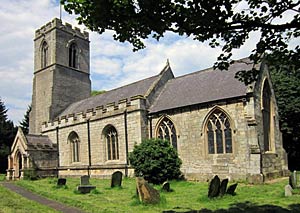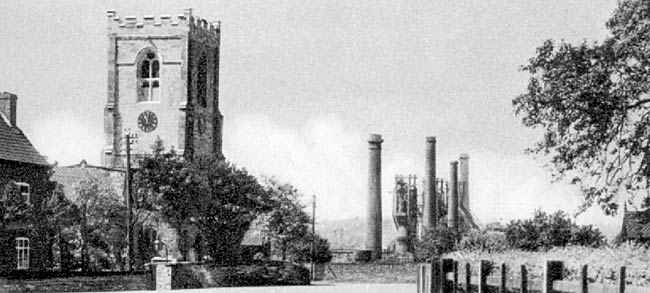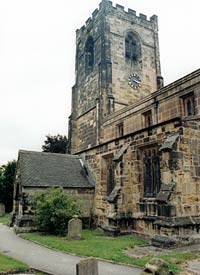< Previous | Contents | Next >

St John the Baptist, Treswell in 2012.
© Copyright Ian S and licensed for reuse under thisCreative Commons Licence.
TRESWELL. It looks out to Lincoln cathedral 15 miles away when the day is clear. Its simple little church, with warm buff tints in the grey stone walls, is in a churchyard with fine trees (horse-chestnuts, limes, and firs) bounded on one side by the little Lee Beck, and on another by the rector's garden.
The lofty tower is 15th century. From the 14th come the doorway within the pretty rebuilt porch and the fine little chancel with beautiful tracery in its big windows. Built into a wall is about two-thirds of a fine Norman coffin stone, with stem and crosshead carved in relief. The north arcade is 15th century, its end arches, like the tower arch, resting on embattled corbels. The massive font is 500 years old and is carved with flowers in quatrefoils. The villagers take communion from a silver chalice of Elizabeth's day.
The Last of His Line

Trowell church and Stanton Ironworks in the 1930s.
TROWELL. Collieries and ironworks are in its near view, but from the crown of the hill and the top of the church tower is a fine panorama of the Erewash Valley, and richly wooded hills with Charnwood Forest on the horizon. In the 15th century tower are the works of the old clock which used to tell the time in the biggest open marketplace in England, the great space in front of the Council House at Nottingham.

Trowell church in 2003.
The clerestory is as old as the tower, and the nave arcades are 14th century. From the close of that century come the buttresses, the stone-roofed porch, the square-headed windows, and the beautiful font with quatrefoils and an embattled edge. The 13th century chancel has its old sedilia and piscina, a narrow arch reaching nearly to the roof, and a modern east window with angels looking down on Mary, Our Lord enthroned, and St Helena by a great cross. It is one of only two coloured windows, both showing fine figures in jewelled raiment; the Crucifixion is in memory of a rector's son who did not come back.
A wall monument to William Hacker (who has been sleeping here since 1668) recalls a family famous in the county; his cousin led Charles Stuart to the scaffold. In the farmhouse facing the church is part of the old home of the Hackers of Trowell, and it was here that the last of this line, Sir John, broke his neck by falling downstairs in 1735. He lies in the church.
